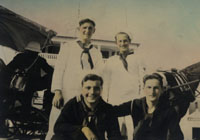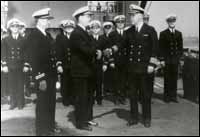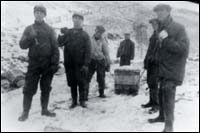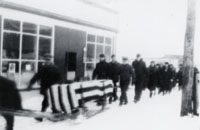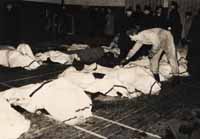Chapter 8: The Story – Dead Reckoning
Rescue, Part II – The Pollux
Back at Lawn Point, the sun was setting and about 122 men were stranded on an icy ledge at the base of a tall cliff. The tide was coming in and threatening to wash some of the survivors out to sea. Separated from these men and trapped in a cave was a group of about a dozen or so more survivors; among them were Lloyd and Calemmo, who had come to shore in the whaleboat with Garnaus, Greenfield, and DeRosa.
The men in the cave were relatively safe for now, but the situation was worsening for those on the ledge. Without warning, one man slipped and fell. His companions quickly formed a human chain to try and reel him in, but with no luck – another death on an already harrowing day. With the tide rising and the temperature dropping, it seemed as though all hope was lost when suddenly one of the survivors spotted a line of men appear at the top of the cliff. At last – a rescue party had arrived!
Everyone thought it was the US Navy, but it was the eight men from Lawn. They quickly went to work, rigging a line to pull people over the cliff, chopping firewood, and preparing a sheltered area for the survivors. It was already late and the rescuers knew that by the time they hauled the last survivors off the ledge, it would be impossible to walk to town through the darkness and bad weather. They would just have to spend the night huddled at the top of the cliff.
The survivors watched anxiously as their rescuers lowered a rope to the ledge. When it was within reach, they tied it around the chest of the first man and signalled for the Newfoundlanders to pull him up. It was slow backbreaking work for the men from Lawn and a nail-biting wait for the men below. Time was important: the tide was rising and every now and then a man slipped off the icy ledge and disappeared into the water below. But the Newfoundlanders could only pull up one survivor at a time because it took five of them to haul a single sailor over the steep rock face. With blistered and bleeding hands, they worked through the long cold hours of a February night. The three men who weren't working the line helped direct the sailors to the make-shift shelter and chopped whatever wood they could find to keep the fire burning.
Eventually, more rescuers from St. Lawrence showed up to help the Lawn eight and they were accompanied by some men with the US Navy. Among them was a doctor who administered stimulants and other medicine to the worn-out survivors. By now, about 30 sailors remained on the ledge and the men from Lawn were in desperate need of a break – they gratefully handed over the rope to the new arrivals. As the night wore on, increasing numbers of rescuers travelled to the cliff top. They brought food with them, which they distributed among the ravenous survivors. “I ate ice-cold pepper-pot soup right out of the can,” Henry Strauss later wrote for the magazine Oceans. “I didn't think anything could taste so delicious.”
Finally, shortly after midnight, the Newfoundlanders and rescuers from the US Navy pulled the final survivor over the cliff top. It was Commander Turney, who had refused to leave the ledge before seeing all the men under his command lifted to safety. When he approached the fire at the top of the cliff, the sailors gave him a second round of applause. The worst part of the ordeal was over for them, but what about the men still trapped in the cave? They had been there for more than 14 hours and the situation was becoming desperate. Someone had managed to build a small fire, but it wasn't nearly enough to stave off the bitter cold of a winter's night in the North Atlantic. Eventually men started to die. “I now learned that freezing to death is very easy and quiet,” Calemmo later remembered. “It seems you just get tired from the lack of circulation and go to sleep. As we sat around in a circle, a guy would get suddenly very quiet and wouldn't answer. A little shove and over he would go, deader than a doornail. I don't remember how many froze in the cleft.” (Tape 38, 19:56-20:19)
Suddenly Calemmo heard what sounded like ice and rocks falling from above. He looked up: “I saw what I thought was a miracle – an angel from heaven or God himself.” (Tape 38, 21:43-21:47) But it was a Newfoundlander being lowered into the cave by his fellow rescuers. He quickly tied a rope around the chest of the closest sailor and called to his companions to pull him to the top. One by one, the last remaining survivors left the cave and joined their fellow sailors around the fire. There they spent the last few hours of darkness. Some men froze to death in the clump of trees, but most made it through the night. In the end, 93 men from the Pollux died and 140 lived.
Dawn broke cold and crisp on February 19 as the weary group made its preparations to leave. The Newfoundlanders filled their sleds with unconscious and injured men first and then set off for St. Lawrence. Survivors who felt strong enough to walk followed on foot, but many stayed behind and waited for the sleds to return for another trip. Their wait was not too long, however, because many more rescuers began to arrive with their sleds and horses to bring the survivors to Iron Springs Mine, about six miles away.
